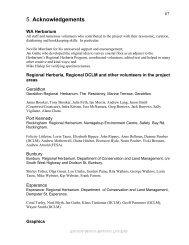Nuytsia 8: 3 (1998) - FloraBase
Nuytsia 8: 3 (1998) - FloraBase
Nuytsia 8: 3 (1998) - FloraBase
You also want an ePaper? Increase the reach of your titles
YUMPU automatically turns print PDFs into web optimized ePapers that Google loves.
Paul G. Wilson, Helipterum: Part 1<br />
Annual erect herbs pubescent with gland-tipped septate hairs. Leaves cauline, alternate, linear.<br />
Capitula solitary and terminal to long branches, radiant. Involucre hemispherical; bracts c. 4-seriate;<br />
outer bracts elliptic, hyaline, long-ciliate with a brown narrow-oblong flat stereome; innermost bracts<br />
with a narrow-elliptic hyaline long-ciliate claw, a narrow-oblong stereome, and a yellow elliptic<br />
lamina. Receptacle minutely glandular papillose. Florets numerous, bisexual, actinomorphic.<br />
Corolla: tube slender, glandular pilose; limb campanulate, glabrous; lobes five, ovate, vascular<br />
strands extending to tips. Anther; appendage ovate, thin, marginal cells differentiated, basal cells ±<br />
equilateral, medial and distal cells narrow-oblong; tails slender delicate, extending to beyond collar.<br />
Style apex truncate; vascular strand prominent, extending almost to tip. Achene narrow-elliptic,<br />
compressed, extending into a terminal beak, minutely papillose with 2-celled tooth-like trichomes;<br />
carpopodium annular, short; pericarp: outer layer of 1-cell thick layer of thin-walled cubical cells;<br />
inner layer of 2-3 rows of thick walled sclerenchymatous cells; testa extremely thin, more or less<br />
adherent to pericarp; endosperm thin, free from testa; vascular strands of pericarp lateral (in relation<br />
to cotyledons); vascular strand of testa passing almost completely around seed in lateral position.<br />
Pappus bristles filiform, barbellate, united below to form a cup-shaped base, entire or slit on one side,<br />
persistent.<br />
Haptotrichion conicum had been placed in Waitzia since it possessed beaked achenes. It differs<br />
from Waitzia most obviously in 1) having a different type of indumentum (not cottony), 2) having broad<br />
flat hyaline claws to the inner involucral bracts (not terete and firm), 3) in having truncate style apices<br />
(neither ellipsoid nor deltoid), and 4) in having delicate filamentous anther tails (not slender and firm).<br />
Haptotrichion further differs from Waitzia in the anatomy of the achene for its pericarp has an outer<br />
single-celled layer of thin-walled cube like cells and an inner layer of several rows of thick-walled<br />
sclerenchymatous cells, while the testa is extremely thin and delicate. In Waitzia the pericarp consists<br />
of a thin layer of hyaline linear cells while the testa is thick, rugose, and made up of thick-walled<br />
collenchyma. The vascular strand in the testa of Haptotrichion passes almost completely around the<br />
seed but in Waitzia it is confined to the base.<br />
From Pterochaeta this genus differs in the manner of branching of the stem and inflorescence (q.v.),<br />
in the nature of the involucral bracts, the nature of the corolla, and the nature of the anther apiculum.<br />
In Pterochaeta, Haptotrichion and Waitzia the achenes are beaked and bear tooth-like 2-celled<br />
trichomes but in other characters the genera are very distinct.<br />
The genus consists of two species, both endemic to the Carnarvon District (Beard 1980) of Western<br />
Australia.<br />
Haptotrichion colwillii Paul G. Wilson, sp. nov. (Figure 6)<br />
Herba erecta ad 25 cm alta. Rami glanduloso puberuli sub capitula pilosi. Folia linearia, 8-15 mm longa,<br />
glanduloso puberula. Involucrum hemisphaericum, c. 10 mm altum et latum; bracteis exterioribus late<br />
ellipticis, hyalinis, ciliatis; bracteis intimis ungue anguste elliptico, c. 9 mm longo, hyalino, ciliato, limbo<br />
anguste obovato obtuso, 9-15 mm longo, luteo. Corolla c. 5 mm longa, tubo glanduloso hirtello, limbo<br />
anguste turbinato, glabro, intra sub lobis papilloso. Achenium anguste ellipsoideum c. 2.5 mm longum,<br />
denticulatum; rostrum gracile, laeve, ad 3 mm longum. Pappus persistens, setis in basi connatis,<br />
tubiformibus.<br />
Typus: 7 km S of Overlander Roadhouse [c. 170 km S of Carnarvon], Western Australia, 1 Sept. 1985,<br />
H. Demarz 10702 (holo: PERTH).<br />
423




